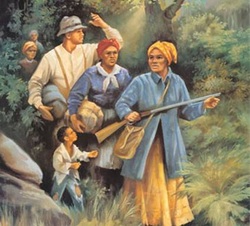 by Yoon Joung Lee During the American Civil War, there was a woman called “Moses” by hundreds of slaves. Harriet Tubman, a runaway slave from Maryland, was born around 1820. She was an abolitionist, Civil War spy, nurse, humanitarian, and Underground Railroad conductor. She was the fifth of nine children. As her parents were slaves, she was naturally born into slavery. She had a harsh childhood and was whipped even though she was very little. When she was 12 years old, she got a serious injury after she was hit on her head by a two-pound iron weight thrown by one of the slave overseers. The incidence was caused initially because Harriet blocked a doorway to protect another slave who attempted to escape. This event brought her narcolepsy which is a sleep disorder that causes excessive sleepiness and frequent daytime sleep attacks. This condition followed her for the rest of her life. She married a free African American man named John Tubman in 1844. In 1849 she decided to run away because she was afraid of being sold or sent to the South after the farm owner of her and her family died. With the help of her white neighbor, Harriet was able to reach Underground Railroad that was a secret network of “safe houses” that helped slaves to move safely from one place to another, and eventually their way to the Canadian border. Despite Harriet’s successful escape to the South, she went back to the South a year later to rescue her sister and her kids. On her second return she saved her brother and two other slaves. When she made the dangerous third trip back to the South to rescue her husband, she found out that he had another wife and she instead came back with other slaves who longed for freedom. After she escaped from slavery, Harriet made total 19 trips to the South to bring slaves to the North where they could gain freedom. As one of the conductors who travels with slaves to escape at Underground Railroad, Harriet had saved approximately 300 slaves from the South, and about 100,000 slaves were able to escape during a 40-year-period with the help of the Underground Railroad. What made her extremely courageous and confident was her belief that God was aiding and equipping her throughout her journey as a "conductor." There were times when she had to be aggressive to lead the slaves out of the slavery. She used to take out a gun and threaten them, saying "Do you want to die here or gain your freedom?" She required obedience from the slaves, and they also knew they could successfully escape only when they followed her guidance. For them, Harriet was known as "Moses" who saved the people of Israel from Egyptian slavery. She was a friend with many influential people of the time. In the mid-1850s, she met a US senator and a former New York State Governor William H. Seward. The couple later provided her with various help, and offered her and her family houses to stay in when she was no longer on the road after the Civil War. She also befriended with abolitionists John Brown, Frederick Douglas, Jermin Louguen and Gerrit Smith, and closely worked with them to fight slavery. While she was guiding a group of African American soldiers in South Carolina after the outbreak of the Civil War, she met her future husband, Nelson Davis who was 10 years younger than Harriet. They got married when she moved to Auburn, New York after the end of the Civil War. They built their house and spent the rest of their lives in Auburn. During the time in Auburn, she continued to passionately work for human rights including womens' and keep in touch with her beloved friends, William and his wife, Frances Seward. Harriet died in 1913 in Auburn, New York, at her age of 93. Her heroic life still inspires many people in the United States. Comments are closed.
|
Archives
July 2017
Categories
All
|
 RSS Feed
RSS Feed